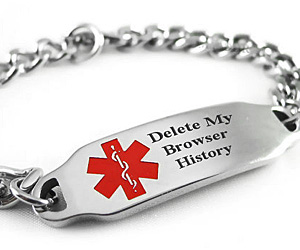I recently discovered a service cleverly named Eternime. Eternime boasts taglines such as “Who Wants to Live Forever?” and “Become Virtually Immortal.” Eternime offers to preserve your digital identity so that your memory and legacy can live on, and potentially interact with future generations, forever. I expect this will eventually become known as the poor man’s Technological Singularity. Think about that. Right now, Eternime believes that enough information about you exists online to fashion a virtual replica that could interact and answer questions. But, is that true? Is there enough information out there right now to start having conversations with yourself?

Eternime collects your thoughts, stories and memories, curates them and creates an intelligent avatar that looks like you. This avatar will live forever and allow other people in the future to access your memories.
Let’s take Facebook for example. Unequivocally the most popular social media platform, Facebook’s highly personalized, intimate experience and perpetual addition of features attracts new users everyday. Many new features are intended to supplant entire industries; a calculated move to keep users from ever leaving the platform. Users can now see current weather conditions right in their News Feed, keep track of daily events in their social circle, make telephone calls, send and receive money, send text messages, and request an Uber. From credit card information to decades of intimate conversations, the amount of personal information stored within the typical Facebook account is staggering and mildly terrifying. At this point, the idea of a stranger rummaging unattended in my house is less disconcerting than handing over unfettered access to my Facebook account.
This scenario brings up a number of interesting questions. What happens to our social media accounts, our digital identities, when we’re gone? Who owns them? Who can legally control them? It turns out the answer varies by platform. If you’re the kind of person that likes to do the heavy lifting themselves, here are the terms & conditions for the most popular social media platforms: Facebook, Instagram, Snapchat, Twitter, Google, Youtube, Pinterest, LinkedIn, and Tumblr.
For the rest of you…
To ensure your wishes are legally memorialized, the first step is to add specific language to your will dictating how you would like your accounts to be handled. The best practice is to include all accounts you own in your will, from email and social media accounts to personal blogs. Like an executor of your tangible property, you can name a social media executor in your will to be responsible for carrying out your wishes for your digital identity. Be sure your will specifies that your social media executor be furnished a death certificate, as many platforms require such documentation.
As with all things social media, Facebook is leading the field in personalized legacy planning. The administrator of the deceased’s online estate has two options. First, they can opt to delete the user’s account, sending the account to the digital-equivalent of the graveyard. This option will allow new registering users to claim the deleted account’s username.
The second option for the administrator of the online estate is to turn the deceased user’s account into a memorialized page. With this option anniversary reminders, birthday notifications, and friends you may know prompts will be disabled. And, unless the user added a Legacy Contact (discussed below), new friend requests will be disabled as well. Once memorialized, only friends of the account will be able to view the account’s memorialized page, its prior posts, and pictures.
A feature unique to Facebook is the Legacy Contacts option. This allows a Facebook account holder to choose a Facebook contact to manage the profile upon the users death. Legacy Contacts are able to take basic actions such as pinning a post on your Timeline, responding to new friend requests, and updating your profile picture. However, Legacy Contacts cannot post to your page as you or access your messages. You also have the option to allow your Legacy Contact to download a full copy of the content you have shared on Facebook. This may include posts, photos, videos, and information from the About section of your profile. Creating a legacy contact is a relatively simple process:
Go to “Settings,” then select “Security Tab.” Once there, you will have the option to select your Legacy Contact. Watch my video on adding a Legacy Contact.
If the account user fails to designate a legacy contact, a third party family member seeking to administer the account must send proof of death and proof of their relation to the deceased user to Facebook administrators. A copy of the death certificate is sufficient to establish proof of death, and a link to an online obituary may be acceptable proof to an administrator. Reasonable documentation to prove family relation to the deceased may also be necessary. Such documentation may include:
- Birth certificates
- Marriage licenses
- Household documents such as bills and notarized documents
- An obituary that names next of kin
Facebook acquired Instagram in 2012, and since then the two social media sites have deployed similar terms when it comes to deceased account holders. However, the glaring difference is the absence of a Legacy Contact on Instagram. Like Facebook though, the same two options to administer the user’s account are available: delete the account or request that the page be memorialized. To request that an account be memorialized a report can be filed HERE. To request that an account be deleted the deceased user’s social media executor or family member must fill out This Form and upload the same acceptable documentation (birth certificates, marriage licenses, household documents such as bills, notarized documents, obituary naming next of kin) as well as proof of legal authority to Instagram administrators. This information can be accessed on the app by clicking on the gear symbol in your profile at the top right of the screen, then pressing the “Help Desk” tab, then typing in a search string such as “Death of an account user.”
Similar to Facebook, Google offers account holders the option to decide how they would prefer their accounts to be handled. Information on designating a third-party administrator can be found here. However, if the user elected not to define their wishes, family members are given three options:
First, with proper documentation, a family member or executor may have the account and all contents permanently deleted.
Second, a family member or executor can request access to an account. However, Google requires a court order before providing access to accounts. As a social media user, I appreciate this stance on the issue. The contents of your Google profile are likely to be highly sensitive and personal, perhaps more so than Facebook, due to Google’s plethora of interrelated products.
Third, a family member or executor may wish to retrieve funds from the user’s account. Like the second option, Google requires a court order proving the requesting party is entitled to receive the funds.
YOUTUBE
Google purchased YouTube in 2006, and since then users have been able to use YouTube with their Google account, without the need to log in separately. Although both sites appear to operate under one account, if you wish to delete a YouTube account it must done separately. Simply deleting the corresponding Google account will not delete the YouTube account.
Deleting the YouTube account of a deceased person is more complicated than the previous platforms. Without possessing the account login information, it is unlikely a family member will be able to have the account removed. You can find more information on YouTube’s official support page. YouTube reserves the right to remove inactive accounts, but their methods of choosing which inactive channels and videos are removed seem arbitrary at best.
Based on Twitter’s policy, the need to remove an account should be as simple as waiting a few months. Twitter’s terms and conditions state that any inactive account may be deleted after 6 months of inactivity. However, a quick search of accounts shows that Twitter doesn’t proactively enforce that rule.
Per their policy, Twitter will not provide access to accounts, regardless of the relationship, absent a court order, or if public policy demands access on a case by case basis. However, Twitter will respond to requests to have accounts deactivated. To submit a request to have an account removed click HERE. After submitting a request, Twitter will send detailed instructions by email. Twitter recommends compiling the following information before proceeding:
- The Username of the deceased user’s account (@example)
- A copy of the death certificate
- Your first and last name
- A copy of your driver’s license
- Your email address
- Your contact information
- Your relationship to the deceased user
- The requested action (deactivate Twitter account)
- A link or copy of the obituary
In certain instances, out of respect to family members, Twitter may remove images of the deceased user upon request. When determining whether information should be removed Twitter considers public interest factors, such as whether the information is news worthy or if the user was a celebrity. The same link above can be used to request the deletion of private information. Unlike Facebook, once a username has been claimed a new account can never use that name again. More information on requesting removal of a Twitter account can be found HERE.
Absent a court order, Pinterest expressly forbids access by third parties to a deceased user’s account. Pinterest does not allow accounts to ever be deleted, only deactivated. To request that an account be deactivated send an email to: care@pinterest.com Include the following information in the request: Your full name, full name and email address of deceased user’s account, a link to the Pinterest account (search under users), documentation of death such as a death certificate or obituary. Finally, proof of relation is required. Examples of documentation needed to establish relationships are: birth or marriage certificate, family and household records, notarized documents, and obituary listing next of kin. Pinterest will then deactivate the account and the account will never be accessible again. The user name of deactivated accounts will not be available to new users registering for an account. Learn more about deactivating a Pinterest account HERE.
SNAPCHAT
Due to the fleeting nature of Snapchat, where images appear briefly and then disappear forever, Snapchat has chosen not to define clear guidelines for deleting the account of a deceased person. Currently no process exists to memorialize or request deletion of an account. If the family member or executor wishing to delete an account has an account themselves, they can email Snapchat in the help tab. However, Snapchat points out that administrators “may not be able to reply individually.”
If the family member or executor is not a Snapchat user, the only way to request that a third party’s account be deleted is by clicking the “I Need Help” link. From there, check the box that states “I have a safety concern, then click the “A Snapchat Account box.” Currently, the only option that resembles a third-party account deletion process is by checking the box that states, “I want to remove my child’s account.” After requesting removal your child’s account, there is an option to send a personal message to Snapchat administrators that the family member can use to explain the situation of a deceased user.
Keep in mind, this process is not currently endorsed by Snapchat, but based on their terms, may be a viable workaround. Snapchat offers no guidance for the procedure in their terms and conditions or public policy. We reached out to Snapchat for a comment, but true to their word, they “may not be able to reply.”
LinkedIn, like most platforms, does not offer users the option to name an administrator of their account in the event of death. Unless removed the deceased’s account will last in perpetuity. However, LinkedIn employs a rather straight-forward process to request that an account be deleted. To request that an account be deleted users should complete this Form. LinkedIn will then review the submission and contact the requesting party. LinkedIn recommends gathering the following information before proceeding:
- The member’s name
- The URL to their LinkedIn profile
- Your relationship to them
- Member’s email address
- Date they passed away
- Link to obituary
- Company they most recently worked at
More information on removing a deceased LinkedIn user’s account.
TUMBLR
Tumblr does not currently have an option to name an account administrator in the event of death, and has not codified a process for the removal of a deceased user’s blog. However, for a potential workaround, visit the Account Management page, click the Contact Us button at the bottom, and provide the details of your request. If you have tried this method please let us know how it worked out. If you think Tumblr should add his feature, you can also send a Feature Request through the Account Management page as well.
At this point, I am on the waiting list for an Eternime account, but I’ll keep you posted on the status of my virtual clone. In the meantime, you can send any questions or comments you have.
You can find me on Twitter, Instagram, Facebook, & LinkedIn.
The book discussed in this podcast episode was Mindset by Dr. Carol Dweck. You can purchase the book HERE.










